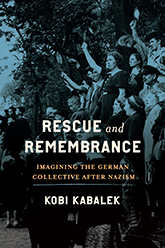|
Rescue and Remembrance
Imagining the German Collective after Nazism
Kobi Kabalek
George L. Mosse Series in the History of European Culture, Sexuality, and Ideas
Steven E. Aschheim, Annette Becker, Skye Doney, and David J. Sorkin, Series Editors
“This original and insightful account will be an essential addition to the library of anyone interested in the memory of the Holocaust, in particular the purposes to which the notion of rescue has been put since the war.”
—Mark Roseman, Indiana University
How do Germans in the past and present remember those who rescued Jews during the Holocaust?
In Rescue and Remembrance, Kobi Kabalek examines how the rescue of Jews during the Holocaust has been understood and represented in Germany from the Nazi period to the present in order to trace Germans’ notions of collective morality. In many countries outside Germany, people speak of a small number of known Holocaust rescuers to claim the pro-Jewish sentiment of broad segments of their country’s population during World War II, thereby projecting an image of national moral virtue. By contrast, current German scholarship and commemoration present rescuers as a small minority; their examples condemn the majority by showing what Germans could have done but did not do.
Kabalek argues that such simplistic depictions of the majority versus minority obscure the complex motivations and situations that led people in Nazi Germany to help persecuted Jews. He shows that portrayals and interpretations of helping Jews appeared in various media and social discourses in East, West, and unified Germany and were used to actively debate questions of collective morality. Rescue and Remembrance analyzes the varied and changing depictions of rescue in the distinct German polities from the Nazi period, examining how the very notions of “majority” and “collective” were articulated and reformulated.
Kobi Kabalek is an assistant professor of Holocaust studies and visual studies in the Germanic and Slavic languages and literatures and Jewish studies departments at the Pennsylvania State University.
Praise
“A complex and multifaceted understanding of the commemoration of ‘rescue’ in postwar Germany. This is an important contribution to our understanding of memory—and historiography—as a heterogenous, dynamic tool for understanding and shaping the present. Kabalek shows admirable tolerance for historical gray areas—for accepting ambiguity and flexibility not only in history but also in its actors and their deeds.”
—Stefanie Schüler-Springorum, Center for the Study of Antisemitism, Berlin
Table of Contents
|

Larger images
January 2025
272 pp. 6 x 9
10 b/w illus.
|

